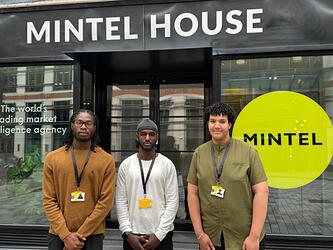The nature of big data
Don’t be confused by the giraffes. This column is about big data. It’s about giraffes too, but they’re pretty much incidental to the point I’m trying to make. Perhaps I should explain.
My brother-in-law Dave studies zoology. Recently he was telling me about a study he and his classmates were carrying out involving zoo giraffes. They had to observe the giraffes and make a note of what they were doing every five minutes in order to assess the impact that living in captivity had on their behaviour.
“Our big data sets are captive. They describe the behaviour of people within certain, defined environments – whether it’s on the internet, or in relation to a specific brand, product, service or aspect of their life. That’s a problem”
“At the outset,” he said, “you think it’s a privilege to be able to sit and watch these beautiful animals.” But that feeling wears off after spending 120 hours in a freezing-cold car with a numb backside and stiff shoulders. “It was really, really boring,” he admitted. “It got to the point where I couldn’t easily distinguish between the giraffes, so I began to realise there would be errors in my data. Also, because they were in a group, I couldn’t always see what they were doing. And eventually I forgot that they were giraffes. They were just things – the subject of this tedious job I had to do – and I couldn’t wait for it to be over.”
So what does that have to do with big data? Well, we know that observed behaviour data is important. People often don’t do what they say they’ll do and have trouble sometimes explaining why they’ve done what they’ve done. This is equally true of giraffes.
But where the real similarities lie is that, like Dave’s giraffes, our big data sets are captive. They describe the behaviour of people within certain, defined environments – whether it’s on the internet, or in relation to a specific brand, product, service or aspect of their life.
That’s a problem in itself. But the bigger issue is that reducing customer behaviour to a bunch of ones and zeroes makes it’s easy to forget the human behind the numbers. Again like Dave, we become detached from our subjects. And by becoming detached, we stop appreciating them for what they are.
At a recent conference, an internet entrepreneur was heard to recommend that start-ups get customers to pay for the privilege of being the test-bed for new products and services which are launched early and then perfected whilst live – rather than go to the trouble of paying for some upfront research.
Is that anyway to treat your customers? To my mind, small data – which provides us with windows into the real worlds of individuals – makes this kind of product experimentation feel more awkward. There’s a level of intimacy inherent in small data that prevents us from becoming detached. The observer recognises human qualities, whether shared or not, in the observed. And moving beyond observation to interaction creates empathy.
Arguably, that empathy is a crucial element of product or service design – and it’s something that big data alone can’t deliver. In addition, through that window we are seeing the customer in the round, not in captivity. We see a whole person; not just traces of behaviour when they are operating in a fenced-off environment.
Of course, big data and small data in tandem will give us the most complete picture of customer behaviour. But as a customer, I know I’d much rather be the star of a BBC Wildlife documentary than the subject of a student zoology project. “Come and watch me do my thing in the wild,” I’d say. “You’ll get a much better idea of who I am.”
Jeremy Rix is founder and chief listener at Oko. He’s online at www.engageoko.com. Rix is presenting a workshop to co-create the future of research at MRS Annual Conference on 19 March. More details at www.mrsannualconference.com

We hope you enjoyed this article.
Research Live is published by MRS.
The Market Research Society (MRS) exists to promote and protect the research sector, showcasing how research delivers impact for businesses and government.
Members of MRS enjoy many benefits including tailoured policy guidance, discounts on training and conferences, and access to member-only content.
For example, there's an archive of winning case studies from over a decade of MRS Awards.
Find out more about the benefits of joining MRS here.












1 Comment
Devon Kinkead
13 years ago
Agreed, Jeremy -- big data and predictive models only help us improve the odds of a successful interaction based on what we observe in the setting in which we observe it.
Like Reply Report